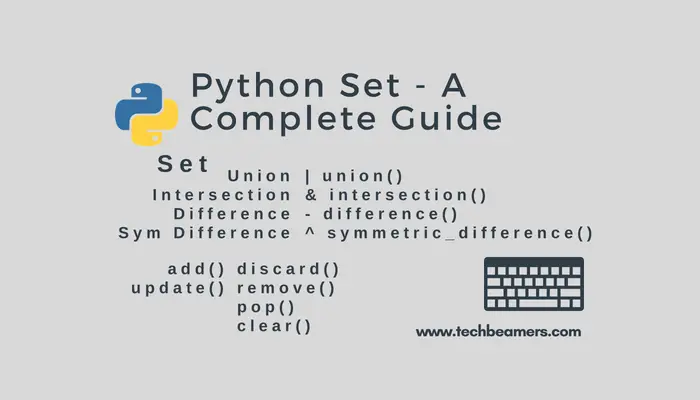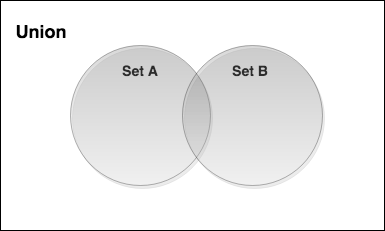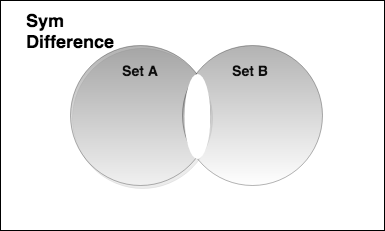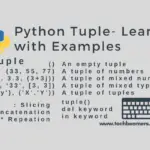Python Set is a programmatic form of sets in mathematics and one of the core data structures in Python. It is an unordered and unique collection of immutable objects. But it is in itself mutable by default.
In this class, you’ll discover – what is a Python set and what are its properties. You’ll learn how to create a set object and add and remove elements in it.
Moreover, the tutorial also provides examples to understand the different operations such as Union, Intersection, Difference, and Symmetric difference.
Understanding sets in Python
Set is a term that originates from Mathematics. But, in Python, it is a collection-type object which can store elements of different data types in Python. It doesn’t index the values in a particular order.
Properties of a Set
A Python set has the following characteristics.
- The elements don’t have a specific order, and their positions can be inconsistent.
- Each item is unique in a Set and, therefore, can’t have duplicates.
- The elements are immutable and hence, can’t accept changes once added.
- A set is itself mutable and allows the addition or deletion of items.
With Sets, we can execute several mathematical operations such as Union, Intersection, Symmetric Difference, and Complement.
Create a set in Python
You can invoke any of the following two methods to create a Python Set.
- If you have a fixed set of elements, then group them using a comma as the separator and enclose the group inside curly braces.
- Another way is to call the built-in “set()” method, which can also be used to add elements at run-time.
Also, remember, the elements can be of any data type such as an integer, float, tuple, or string, etc. The only exception with a set is that it can’t store a mutable item such as a list or dictionary. Read our detailed guide on Python lists and understanding dictionaries in Python.
# create a set of numbers
py_set_num = {3, 7, 11, 15}
print(py_set_num)
# create a set of mixed data types
py_set_mix = {11, 1.1, "11", (1, 2)}
print(py_set_mix)Executing the above code will return the following output.
# output
{3, 11, 7, 15}
{(1, 2), 1.1, 11, '11'}Follow one more example of Python Set to gain more clarity.
# set can't store duplicate elements
py_set_num = {3, 7, 11, 15, 3, 7}
# it'll automatically filter the duplicates
print(py_set_num)
# create a set using the set() method
# creating set with a fixed set of elements
py_set_mix = set([11, 1.1, "11", (1, 2)])
print(py_set_mix)
# creating set with dynamic elements
py_list = [11, 1.1, "11", (1, 2)]
py_list.append(12)
print(py_list)
py_set_mix = set(py_list)
print(py_set_mix)Check out the result of the above code after execution.
# output
{11, 3, 15, 7}
{(1, 2), 1.1, 11, '11'}
[11, 1.1, '11', (1, 2), 12]
{(1, 2), 1.1, 11, '11', 12}Let’s now do one more test with sets. We’ll not try to create an empty Python Set.
# Let's try to create an empty Python set
py_set_num = {}
print("The value of py_set_num:", py_set_num)
print("The type of py_set_num:", type(py_set_num))
py_set_num = set()
print("The value of py_set_num:", py_set_num)
print("The type of py_set_num:", type(py_set_num))Here is the explanation of the above code.
The first statement would result in the creation of a dictionary object instead of creating a set. You can’t just use curly braces and expect a “Set” in return.
While in the next non-print statement, we used the set() function but didn’t pass any argument to it. It will eventually return us an empty Set object.
Please refer to the below output of the last example.
# output
The value of py_set_num: {}
The type of py_set_num: <class 'dict'>
The value of py_set_num: set()
The type of py_set_num: <class 'set'>Add elements in a Python set
Python Set is a mutable object. However, it doesn’t use any indexing, and hence, it doesn’t have any order.
It also means that you can’t change its elements by accessing through an index or via slicing.
However, there are Set methods like the add(), which adds a single element, and the update(), which can add more than one item.
The update() method can even accept tuples, lists, strings, or other sets as an argument. However, duplicate elements will automatically get excluded.
# Let's try to change a Python set
py_set_num = {77, 88}
try:
print(py_set_num[0])
except Exception as ex:
print("Error in py_set_num[0]:", ex)
print("The value of py_set_num:", py_set_num)
# Let's add an element to the set
py_set_num.add(99)
print("The value of py_set_num:", py_set_num)
# Let's add multiple elements to the set
py_set_num.update([44, 55, 66])
print("The value of py_set_num:", py_set_num)
# Let's add a list and a set as elements
py_set_num.update([4.4, 5.5, 6.6], {2.2, 4.4, 6.6})
print("The value of py_set_num:", py_set_num)
In the above example, the first line is demonstrating that a set doesn’t allow indexing. We’ve kept that code inside the Python try-except block so that we can catch the error, print it, and continue with the rest of the execution.
In the next section of the example, you can see the Set’s add() and update() methods in action.
Now, check out the output of the above Python Set example.
# output
Error in py_set_num[0]: 'set' object does not support indexing
The value of py_set_num: {88, 77}
The value of py_set_num: {88, 99, 77}
The value of py_set_num: {66, 99, 44, 77, 55, 88}
The value of py_set_num: {66, 99, 4.4, 5.5, 6.6, 2.2, 44, 77, 55, 88}Access set elements
It’s not possible to access an element directly in a set. But you can fetch all of them together. You need a loop to retrieve a list of particular items over the Set.
# Python set example to access elements from a set
basket = set(["apple", "mango", "banana", "grapes", "orange"])
for fruit in basket:
print(fruit)After executing the above code, you’ll see the following output.
# output apple banana mango orange grapes
Remove elements in a Python set
You can use the following Set methods to delete elements from it.
- Discard() method
- Remove() method
There is a small difference in the way these two methods operate. The discard() method doesn’t throw any error if the target item is not part of the set.
On the contrary, the remove() method will throw the “KeyError” error in such a case.
Follow the below example to get more clarity.
# Let's try to use a Python set
py_set_num = {22, 33, 55, 77, 99}
# discard an element from the set
py_set_num.discard(99)
print("py_set_num.discard(99):", py_set_num)
# remove an element from the set
py_set_num.remove(77)
print("py_set_num.remove(77):", py_set_num)
# discard an element not present in the set
py_set_num.discard(44)
print("py_set_num.discard(44):", py_set_num)
# remove an element not present in the set
try:
py_set_num.remove(44)
except Exception as ex:
print("py_set_num.remove(44) => KeyError:", ex)It’ll generate the following result.
# output
py_set_num.discard(99): {33, 77, 22, 55}
py_set_num.remove(77): {33, 22, 55}
py_set_num.discard(44): {33, 22, 55}
py_set_num.remove(44) => KeyError: 44Apart from the methods you’ve so far seen, there is a pop() method to remove an element.
Also, since the Set doesn’t use indexing, so you can’t be sure which of the item would get popped. It’ll randomly pick one element and remove it.
There is also a method called clear(), which flushes everything from the set.
# Let's use the following Python set
py_set_num = {22, 33, 55, 77, 99}
print("py_set_num:", py_set_num)
# pop an element from the set
py_set_num.pop()
print("py_set_num.pop():", py_set_num)
# pop one more element from the set
py_set_num.pop()
print("py_set_num.pop():", py_set_num)
# clear all elements from the set
py_set_num.clear()
print("py_set_num.clear():", py_set_num)The above example will produce the following result.
# output
py_set_num: {33, 99, 77, 22, 55}
py_set_num.pop(): {99, 77, 22, 55}
py_set_num.pop(): {77, 22, 55}
py_set_num.clear(): set()Python Set Operations
Like in mathematics, the set supports operations like union, intersection, difference, and complement so does it in Python.
There are methods as well as operators available to perform the set operations.
For illustration, we will use the following two sets in the next examples.
# We'll use the setA and setB for our illustration
setA = {'a', 'e', 'i', 'o', 'u', 'g', 'h'}
setB = {'a', 'e', 'z', 'b', 't', 'o', 'u'}Union Operation
The Union of setA and setB is a new set combining all the elements from both Sets.
The “|” operator is the one to perform the union operation on the sets.
# We'll use the setA and setB for our illustration
setA = {'a', 'e', 'i', 'o', 'u', 'g', 'h'}
setB = {'a', 'e', 'z', 'b', 't', 'o', 'u'}
print("Initial setA:", setA, "size:", len(setA))
print("Initial setB:", setB, "size:", len(setB))
print("(setA | setB):", setA | setB, "size:", len(setA | setB))We’ve used the Len() method to calculate the length of the set. The output of the above example is as follows:
# output
Initial setA: {'u', 'i', 'g', 'o', 'e', 'h', 'a'} size: 7
Initial setB: {'u', 'z', 'b', 'o', 'e', 'a', 't'} size: 7
(setA | setB): {'h', 'u', 'z', 'b', 't', 'g', 'o', 'e', 'i', 'a'} size: 10You can also accomplish similar results using the union() method.
# Python set example using the union() method
setA = {'a', 'e', 'i', 'o', 'u', 'g', 'h'}
setB = {'a', 'e', 'z', 'b', 't', 'o', 'u'}
print("setA.union(setB):", setA.union(setB), "size:", len(setA.union(setB)))
print("setB.union(setA):", setB.union(setA), "size:", len(setB.union(setA)))You can apply the union() method on any of the sets (i.e., set A or B); the output will remain the same.
# output
setA.union(setB): {'a', 'o', 'e', 'b', 'u', 't', 'i', 'g', 'z', 'h'} size: 10
setB.union(setA): {'a', 'o', 'e', 'b', 'u', 't', 'i', 'g', 'z', 'h'} size: 10Intersection Operation
The intersection of setA and setB will produce a set comprising common elements in both Sets.
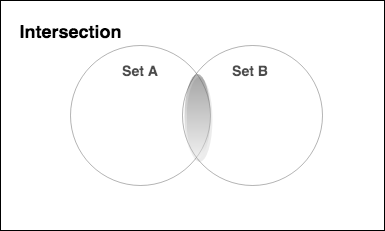
You can use Python’s “&” operator to perform this operation.
# Python intersection example using the & operator
setA = {'a', 'e', 'i', 'o', 'u', 'g', 'h'}
setB = {'a', 'e', 'z', 'b', 't', 'o', 'u'}
print("Initial setA:", setA, "size:", len(setA))
print("Initial setB:", setB, "size:", len(setB))
print("(setA & setB):", setA & setB, "size:", len(setA & setB))This example will produce the following result.
# output
Initial setA: {'e', 'o', 'h', 'a', 'g', 'u', 'i'} size: 7
Initial setB: {'b', 'e', 't', 'o', 'z', 'a', 'u'} size: 7
(setA & setB): {'o', 'a', 'u', 'e'} size: 4Alternatively, you can call the intersection() method to perform this operation.
# Python set example using the intersection() method
setA = {'a', 'e', 'i', 'o', 'u', 'g', 'h'}
setB = {'a', 'e', 'z', 'b', 't', 'o', 'u'}
intersectAB = setA.intersection(setB)
print("setA.intersection(setB):", intersectAB, "size:", len(intersectAB))
intersectBA = setB.intersection(setA)
print("setB.intersection(setA):", intersectBA, "size:", len(intersectBA))This example will produce the following result.
# output
setA.intersection(setB): {'a', 'u', 'e', 'o'} size: 4
setB.intersection(setA): {'a', 'u', 'e', 'o'} size: 4Difference Operation
When you perform the difference operation on two Sets, i.e., <setA – setB>, the resultant will be a set of elements that exist in the left but not in the right object.
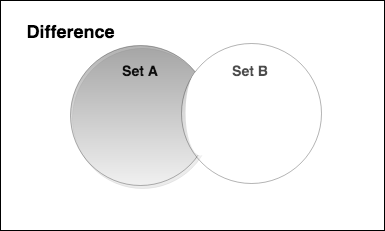
Likewise, the operation <setB – setA> will return those elements of setB which don’t exist in the setA.
You can use the minus (-) operator to carry out this operation.
# Python set's difference operation
setA = {'a', 'e', 'i', 'o', 'u', 'g', 'h'}
setB = {'a', 'e', 'z', 'b', 't', 'o', 'u'}
diffAB = setA - setB
print("diffAB:", diffAB, "size:", len(diffAB))
diffBA = setB - setA
print("diffBA:", diffBA, "size:", len(diffBA))There are three unique elements in both of our input sets that don’t exist in another. Check the output below.
# output
diffAB: {'i', 'g', 'h'} size: 3
diffBA: {'z', 'b', 't'} size: 3The next example will demonstrate the same set of operations using the difference() method.
# Python set's difference operation using the difference() method
setA = {'a', 'e', 'i', 'o', 'u', 'g', 'h'}
setB = {'a', 'e', 'z', 'b', 't', 'o', 'u'}
diffAB = setA.difference(setB)
print("diffAB:", diffAB, "size:", len(diffAB))
diffBA = setB.difference(setA)
print("diffBA:", diffBA, "size:", len(diffBA))The execution of the above example would produce the below output.
# output
diffAB: {'i', 'g', 'h'} size: 3
diffBA: {'b', 't', 'z'} size: 3Symmetric Difference
The symmetric difference between two sets will generate a set of elements that exist in <setA> and <setB> but not in both.
You can execute this operation with the help of the caret operator (^) in Python.
# Python set example using the caret ^ operator
setA = {'a', 'e', 'i', 'o', 'u', 'g', 'h'}
setB = {'a', 'e', 'z', 'b', 't', 'o', 'u'}
symdiffAB = setA^setB
print("symdiffAB:", symdiffAB, "size:", len(symdiffAB))
symdiffBA = setB^setA
print("symdiffBA:", symdiffBA, "size:", len(symdiffBA))The output is as follows.
symdiffAB: {'z', 't', 'h', 'g', 'b', 'i'} size: 6
symdiffBA: {'z', 'h', 'g', 't', 'b', 'i'} size: 6You can also get the operation done with the method symmetric_difference().
# Python set example using the symmetric_difference() method
setA = {'a', 'e', 'i', 'o', 'u', 'g', 'h'}
setB = {'a', 'e', 'z', 'b', 't', 'o', 'u'}
symdiffAB = setA.symmetric_difference(setB)
print("symdiffAB:", symdiffAB, "size:", len(symdiffAB))
symdiffBA = setB.symmetric_difference(setA)
print("symdiffBA:", symdiffBA, "size:", len(symdiffBA))The result is as follows.
# result
symdiffAB: {'z', 'h', 'i', 'g', 't', 'b'} size: 6
symdiffBA: {'z', 'i', 'g', 'b', 't', 'h'} size: 6By the way, you can also try using Python zip() to iterate lists in parallel.
Miscellaneous Set Operations
Set Membership Test
You can surely check if a set contains a particular element or not. You can make use of the “in” keyword for this purpose.
# Python set example to test elements in a set
basket = set(["apple", "mango", "banana", "grapes", "orange"])
# confirm if 'apple' is in the basket
print("Is 'apple' in the basket?", 'apple' in basket)
# confirm if 'grapes' is in the basket
print("Is 'watermelon' in the basket?", 'watermelon' in basket)After executing the above code, you’ll see the following output.
# output Is 'apple' in the basket? True Is 'watermelon' in the basket? False
Frozen Sets in Python
It is a unique type of set that is immutable and doesn’t allow changing its elements after assignment.
It supports all methods and operators as a set does, but those that don’t alter its content.
As you now know that the sets are mutable and thus become unhashable. So, we can’t use them as keys for a Python dictionary. On the contrary, the Frozen Set is by default hashable and can work as keys to a dictionary.
You can create a Frozen set with the help of the following function.
frozenset()
Also, the following Python methods can work with the Frozen set.
copy() difference() intersection() isdisjoint() issubset() issuperset() symmetric_difference() union()
The methods which perform add or remove operations aren’t applicable for Frozen sets as they are immutable.
The below sample exhibits the differences between a standard vs. the frozen set.
# Python Sample - Standard vs. Frozen Set
# A standard set
std_set = set(["apple", "mango","orange"])
# Adding an element to normal set is fine
std_set.add("banana")
print("Standard Set:", std_set)
# A frozen set
frozen_set = frozenset(["apple", "mango","orange"])
print("Frozen Set:", frozen_set)
# Below code will raise an error as we are modifying a frozen set
try:
frozen_set.add("banana")
except Exception as ex:
print("Error:", ex)Summary
We hope that after wrapping up this tutorial, you should feel comfortable using the Python set. However, you may practice more with examples to gain confidence.
Also, to learn Python from scratch to depth, do read our step-by-step Python tutorial. Also, you may connect to our social media accounts to receive timely updates.

